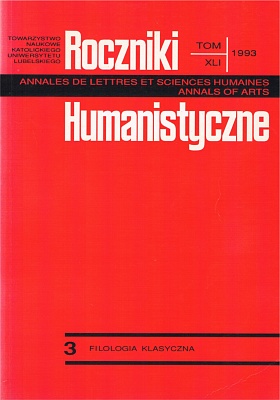On the Principle of Identity in Diversity in the Thought of Heraclitus
Abstract
The present paper is a study in which one proves, by way of an accurate analysis of the chosen passages, the thesis that Heraclitus of Ephesus fully deserves to be called the creator of the theory of opposites. The latter is also called in scientific literature the principle of identity, unity or coincidence of opposites which has a Latin name to it, i.e. coincidentia oppositorum. The thought of a fluctuating nature of reality, made up of opposites, played a fundamental role in Heraclitus’ philosophy. Almost the fourth part of the fragments which have been preserved to date deal with opposites. According to the Ephesian, the world can be understood only by way of the categories of opposites, i.e. as a reality whose existence, and that both in the physical and theological sense, guarantees a continuous tension (motion) between these opposites. The author seeks to prove that the contradictory nature of the Heraclitean being has its source and justification in the theory of the unity in diversity. What makes the author think so is an analysis of the majority of fragments in which the said principle is made use of. The fragments in question have been divided in the paper into a few basic groups. First, there are statements in which the principle of opposites directly or indirectly touches on the being named God. The final fragments of the study discuss this (that is God’s) contradictory nature, called Fire. The names which have been mentioned here are: God (B 67) and Fire which occur also in the texts as Strife (B 53, B 80), Harmony (B 51, B 8, B 54), the only Wisdom (B 32). These are names, as it seems, of the same Being whose presence in the world had various embodiments according to Heraclitus. Each figure of the Being, however, manifests a contradictory nature and reaches out to opposites as its justification. That is why Heraclitus regarded the embodiment of fire as the most appropriate one of that Being. Its fluctuating nature was the most handy to visualise and explain the same fluctuating nature of the world. Heraclitus illustrates such a novel teaching about the world made of opposites with examples in which the principle of unity in diversity embraced various kinds of kinships: 1) mutual sequence and change of qualities or things placed on the opposite poles of the same continuum (that is, continuous and repeatable cycle as seen in day and night, summer and winter, want and surfeit (B 67); 2) relativity of things vs the experiencing object (subject); there is no basic difference between pleasant (good) and unpleasant (bad) aspect of the sea water, mire, clean water, chaff and gold which is proved by contradictory feelings and judgements of fish, pigs, donkeys and people (B 61, B 13, B 37, B 9, B 4, B 58); 3) unity of two opposites comes from the fact that none of them could exist without the other as its „fellow-partner” (B 111, B 84); 4) „identity” of opposites is also guaranteed by various aspects of the same thing (the example with a bow − B 48). All kinds of kinships between opposites mentioned here are, as it were, „links” (B 10) which describe various kinds of relations between particles of the universe in which there dominate two tendencies: from unity to plurlity, and its opposite tendency towards unity. They are the same time foundations of the theory of opposites, because the unity of the world is based on the dynamic contradiction of things, that is to say, on a continuous change between opposites which create those things. Ultimately, all opposites may be embraced only by God (B 67) and His contradictory nature − Fire, making real two hypostases: kindling (want) and going out (surfeit − comp. B 65), beginning and end of life, that is those basic opposites which grant existence to all things. Ultimately, contradictoriness rooted in Fire becomes in the thought of Heraclitus a cosmic power which constitutes the world, that is God in a new, not traditional, image of divinity.
Copyright (c) 1993 Roczniki Humanistyczne

This work is licensed under a Creative Commons Attribution-NonCommercial-NoDerivatives 4.0 International License.





